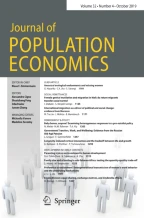887Accesses
3Altmetric
Abstract.
The share of children employed in English cotton factories fell significantly before the introduction of effective child labor legislation in the early 1830s. The early factories employed predominantly children because adults without factory experience were relatively unproductive factory workers. The subsequent growth of the cotton industry fostered the development of a labor market for productive adult factory workers. This effect helps account for the shift toward adults in the cotton factory workforce.
JEL classification: J13, N33, O14
This is a preview of subscription content,log in via an institution to check access.
Access this article
Subscribe and save
- Get 10 units per month
- Download Article/Chapter or eBook
- 1 Unit = 1 Article or 1 Chapter
- Cancel anytime
Buy Now
Price includes VAT (Japan)
Instant access to the full article PDF.
Similar content being viewed by others
Author information
Authors and Affiliations
Centre for History and Economics, King‘s College, Cambridge CB2 1ST, UK, , , , , , GB
Douglas A. Galbi
- Douglas A. Galbi
You can also search for this author inPubMed Google Scholar
Additional information
Received November 3, 1995/Accepted September 20, 1996
Rights and permissions
About this article
Cite this article
Galbi, D. Child labor and the division of labor in the early English cotton mills.J Popul Econ10, 357–375 (1997). https://doi.org/10.1007/s001480050048
Issue Date:
Share this article
Anyone you share the following link with will be able to read this content:
Sorry, a shareable link is not currently available for this article.
Provided by the Springer Nature SharedIt content-sharing initiative

